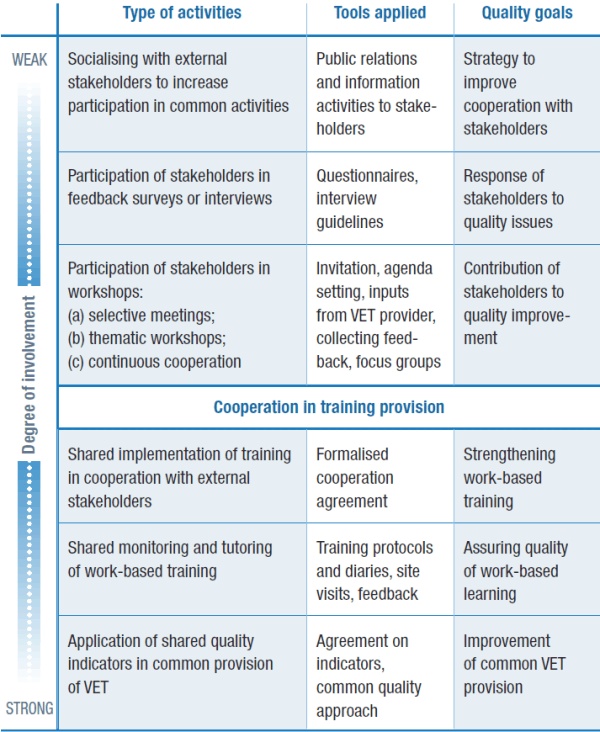While cooperation with employers is a valuable asset for quality of VET provision in general, it becomes a ‘must’ for institutions that include practical training in companies. As in several VET programmes at least some part of training is work-based, quality of this part becomes an inherent and decisive issue for internal quality management.
As the following step-by-step approach for establishing quality in work-based training will show, quality and quality improvement can be built in when cooperation between a VET institution and the world of work is developed.
Establishing quality in work-based learning6
Step 1 making contacts, aims to generate willingness to cooperate and recruit enterprises to provide appropriate work-based learning opportunities. This is usually a long-term endeavour that calls for continuity, networking and establishment of dependable partnerships. VET institutions’ most important starting activities are:
invitations to employers and company representatives to events, presentations of students’ work to the public, visits to companies, joint projects with companies;
engagement with chambers and employers’ associations, preparing the ground for mutually-beneficial collaboration;
invitations to external stakeholders to participate in feedback surveys and interviews.
Step 2 planning work-based learning activities, is mainly under responsibility of the VET institution and must consider legal requirements as well as pedagogical aims:
contractual arrangements setting out rights and obligations of trainees and employers should be clear before the work-based training period starts;
adequacy of training opportunities in enterprises must be ascertained: content of work-based training needs to fit in with the curriculum of the VET programme, and the work-based learning environment should allow acquisition of hard and soft skills;
individual learning plans should be drawn up detailing the competences to be acquired by trainees during the work-based training period.
Step 3 includes tutoring students and monitoring work-based learning through collaboration between the VET institution and in-company trainers, in:
documenting the work-based training process by means of training protocols of in-company tutors and training diaries of trainees;
self-evaluation by trainees and in-company tutors which helps to steer the learning process and detect areas for improvement;
on-site visits of the VET institution’s teachers and trainers to help with supervision of trainees’ performance and provide opportunities for firsthand feedback;
ongoing exchange between the VET institution’s teachers and trainers and in-company tutors to ensure a favourable work-based learning process.
Step 4 encompassing review and evaluation of work-based learning activities, provides information for further improvement:
feedback from trainees and in-company trainers on quality and results of the work-based training can be gathered through surveys and interviews;
evaluation of the work-based learning period should include an objective assessment of the learning outcomes achieved;
additionally, evaluation should build on observations and feedback collected during site visits of the VET institution’s teachers and trainers.
Step 5 refers to improvement and change of work-based learning activities and is based on evaluation results, agreement on a common quality approach and application of shared quality indicators:
evaluation results should be discussed by responsible teachers and trainers in the VET institution; and also
with in-company trainers to draw lessons for the future;
organising reflective workshops or focus groups encompassing all stakeholders may entail improvements of quality, for example better preparation of students, reinforced coordination of work-based and school-based training, adaptation of curricula for VET programmes; leading to
the final result of applying shared quality indicators and agreeing on a common quality approach.
Table 4, which presents a typology of stakeholder involvement, provides an overview of activities that can be undertaken to increase continuously involvement of external stakeholders. The rows at the top of the table apply to all stakeholders, employers, local authorities and graduates, while those at the bottom refer in particular to cooperation with employers for jointly providing work-based learning. Taking an example of implementing work-based learning, Table 4 contains not only the activities, but also the quality goals to guide cooperation activities, as well as several tools supporting attainment of these quality goals.
Table 4. Typology of stakeholder involvement

Source: CEDEFOP.
6 See annex, Sections 1.21, 1.35 and 1.36.
|
Please answer the Questions (in the field Comment) and complete the Quiz as well. |
| Questions: | 1 |
| Attempts allowed: | Unlimited |
| Available: | Always |
| Pass rate: | 75 % |
| Backwards navigation: | Allowed |